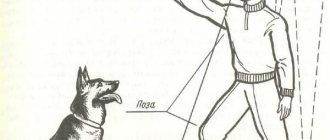Unreasonable barking is a serious problem, but conscious barking is a source of pride for your pet. The ability to bark at a specific signal is included in the standards of training courses for service dogs, but can be useful even for decorative breeds.
To quickly master the skill, it is recommended to enroll in the nearest kennel club. There they will explain to you in detail how to teach your dog the “Voice” command. Self-study uses similar methods, but requires more time and persistence.
The purpose of teaching the command “Voice!”
Dog breeders have an attitude towards the command “Voice!” ambiguous. Some consider it a whim of the owner and completely unnecessary, while others, on the contrary, consider it to be a basic skill.
The dog gives a voice
Team "Voice!" First of all, it is necessary for guard, hunting, shepherd, and service dogs. What is its purpose? The dog expresses its emotions with its voice and gives a signal to the person.
How it works:
- By barking, a guard dog warns its owner about a stranger.
- A hunting dog gives a voice when it has caught its prey.
- The service dog barks when she finds prohibited items that she cannot reach (they can be hidden in a bag, car upholstery, or hung high).
- The shepherd dog warns of approaching danger or uncontrolled behavior of the livestock under its care.
For representatives of other breeds, the ability to vocalize on command is a sign of a disciplined dog.
A service dog uses its voice to notify you of found prohibited items.
Stranger!
Execution of this command is a manifestation of aggression by the dog towards a specific person, but without attacking him. Training should be carried out under the guidance of a canine handler and with the participation of a person unfamiliar to the shepherd who will cause aggression.
Remember that raising a dog comes first, and only then such serious skills as this.
You can teach the “alien” command like this:
- the dog is near the owner;
- the person involved is passing by, he can wave his arms, make small lunges towards the owner, talk loudly;
- the owner pronounces “stranger” in a quiet but clear voice;
- as soon as the shepherd dog begins to bark, growl and prepare to attack, the person involved leaves, and the pet is encouraged with praise.
Important ! It is worth practicing “stranger” with dogs that have reached the age of one and a half years, when the psyche is fully formed.
At what age should you start learning?
How to teach your dog the “down” command at home
Training in “basic”, “necessary” commands begins at 2-3 months. First of all, you need to figure out whether a puppy of a certain breed needs a command. For guard, hunting, and service dogs, the command will be on the list of basic ones, and you can begin to master it when the puppy is three months old.
For other dogs, mostly medium-sized, it is better to start training at 4 months. For representatives of decorative breeds, this command is useless, since it is not needed even at exhibitions. But if the owner still wants his Chihuahua or Yorkie to be able to speak on command, then training should begin no earlier than four months of age.
Basic preparation
It is worth starting training “Voice” at a time when the puppy has already learned the basic commands , such as “Come to me”, “Fu”, “Near”, etc.
For training, try to choose a quiet place so that the dog is not distracted by external stimuli. Alternate home workouts and outdoor workouts, then she will obey you always and anywhere.
Training should be carried out 2-3 times a week. The first workouts can take 30-40 minutes, gradually the time can be increased to an hour.
Do not overtire your dog by practicing just one “Voice” command many times in a row. Repeat all the material, spending some time on the commands you already know.
Pay attention to how your command sounds. Say it clearly and loudly. Your tone of voice can be stern, but avoid any hint of irritation. Do not repeat it several times, try to achieve the desired result on the first try. Stock up on your pet's favorite treat. Give him a treat for every command performed correctly, praise and pet him. It wouldn’t hurt to put yourself in a positive mood; your good mood is an excellent helper for your beloved pet.
What to do if your dog starts peeing at home. Detailed instructions and methods of punishment.
The Beagle is a hound with an independent, friendly character . We will show and tell you everything about beagles in this article.
And here you can read a full description of the husky breed - the national treasure of Americans.
How a dog's psychotype affects learning
As in human psychology, dogs are divided into 4 psychotypes:
- Cholerics are distinguished by activity, curiosity, devotion to the owner and the ability to violate discipline in small ways. This applies to breeds such as Chihuahua, Spitz, Corgi, Husky.
- Sanguine people are no less active than choleric people, but they are able to control emotions and have a high level of discipline. Usually this is a German Shepherd, Labrador.
- Phlegmatic thinkers, distinguished by good nature, do not tolerate monotony, are not flattered by treats, but are responsible for what they consider important. These breeds include Newfoundland, Caucasian Shepherd, Rottweiler.
- Melancholic people are clumsy, slow, doing only the bare minimum. If they see an opportunity not to do something, they will always take it. Among such pets are mastiffs, St. Bernards, and American bulldogs.
How to teach a dog the Fas command at home
The most difficult command to teach is “Voice!” melancholic people who practically do not bark either on their own or when ordered. To explain to the dog the need for a command, you will have to spend a lot of effort and patience.
Sanguine people are the easiest to train. They take the process seriously and internalize commands forever.
Cholerics quickly understand what is required of them, but without systematic repetition, they just as quickly forget what they have learned.
Attention! Mutts constitute a separate psychotype. All 4 types are found among them. How to determine? Just watch the dog.
Ways to teach a team
Studying the pet's temperament and character is necessary in order to decide on the method of training. Among the most effective are:
- training with treats;
- through stimulation of arousal;
- through dependence on the owner;
- stimulation of interest;
- stimulation of security guard qualities;
- method of defensive reaction;
- imitation method;
- through the challenge of "resentment".
Teaching commands using treats
How to teach your dog the “sit” command at home
The dog is placed on a leash, the edge of which is pressed with the foot so that it becomes short enough. Then they show the treat and raise it above the pet’s head. The dog will try to get the treat. After futile attempts, he will begin to bark. At this moment, you need to say a voice command and immediately give the treat. Actions to consolidate the command are repeated at least twice a day.
Attention! With this method of training, the dog may develop an incorrect understanding of the connection between the voice and treats, which will lead to constant barking at the sight of food.
Teaching command through excitement
There are two options for using this method. First: wait until the dog barks in a state of excitement, say the command “Voice!”, and then praise the pet. Second: cause arousal artificially through a game or any other activity. Further actions are the same as in the first case.
Using host dependency
This method is suitable for monogamous dogs, which by nature should always be close to their owner. The person ties the pupil to a tree or any other support and begins to slowly walk away without giving the dog instructions in the form of the command “Place!” The dog will get nervous and start barking. At this moment, the owner pronounces a command and encourages the pet.
Train while stimulating interest
The pet is shown their favorite toy, then they hide it in a desk drawer, closet, or suitcase. The dog will want to play, and due to the inability to get a toy, it will start barking. Then the owner’s actions are usual: say “Voice!”, praise, give the toy.
Training through stimulation of guard qualities
The method is applicable only to guard breeds and mongrels. The dog is tied up in the yard. The “stranger” makes his way into the territory. It’s good if a stranger does this by jumping over the fence. Then the “security guard” will immediately suspect something is wrong.
If “illegal intrusion” is not enough, the helper should approach the dog, showing concern in every way: crouching, looking around, fussing. This must be done until the dog barks. At this moment, the owner gives the command “Voice”, and the stranger quickly leaves.
A guard dog barks while protecting its territory
Defensive reaction method
To implement the method, you will need a volunteer, a support in the form of a tree or pole, an irritating element (rag, stick, bag), and a treat. The dog is tied to a post. The owner stands in the pet's field of vision. A stranger is shown approaching the dog, waving a rag or a rustling bag, imitating an attack on the dog. When the dog reacts to the “villain” and barks, the owner says “Voice!” After this, the “villain” disappears.
Need to take into account! For training, it is advisable to involve a stranger who will definitely not appear in the house again, since for the dog he will forever remain an enemy.
Imitation method
If the puppy cannot learn to give voice on command, they resort to the help of another, already trained dog. The puppy watches from the side as someone else's dog executes the command and receives encouragement for this. The “student,” also wanting to receive a treat or praise, repeats what he saw. The method is effective for an impressionable puppy, but is not suitable for an adult dog.
Calling out "resentment"
To provoke barking, the pet is invited for a walk at the usual time, a leash is fastened and left in the apartment, as if forgotten. The pet, offended, will begin to bark. The owner immediately returns, gives a command and makes peace with the offended person.
The dog was offended that he was not taken for a walk
Choice of incentive
Motivation is one of the most important elements in training. The more desirable the reward, the faster and more willingly the dog learns.
Reinforcement should be selected taking into account the individual characteristics of the pet. All dogs, even of the same breed, can differ greatly in character and needs.
Taste reward
Rewarding with treats is suitable for almost all animals. Food motivation is part of the instinct of self-preservation - to eat means to survive.
Well suited for dogs up to one year old - during the period of active growth, puppies always want to eat and pieces of cheese or meat cause great delight. Training with treats is also good because motivation can be increased by skipping 1-2 feedings.
Game encouragement
Praise in the form of a game is suitable for dogs with pronounced instincts of fetchers and hunters. This option is not suitable for everyone - aboriginal breeds and primitive Spitz dogs are not inclined to play with balls, but true shepherd dogs and hunters, on the contrary, play with pleasure.
Play rewards should only be used if the toy really delights the dog and is a desired object. Otherwise, the pet will quickly lose interest in activities.
Where to train
The training location is closely related to the training method and purpose. Service, hunting and guard dogs must be taught to bark on command in places of “duty” so that the dog simultaneously develops an understanding of the usefulness of the skill.
If the team will be used as entertainment, then a special site is not required.
The choice of training site depends on the training method
Attention! A home environment is one of the most convenient options for teaching a dog to vocalize on demand. However, you need to be prepared for the fact that during the training process the pet may misinterpret the person’s requirements and then frequent violation of silence cannot be avoided.
How to Train a German Shepherd to Show Stance?
Teaching a shepherd dog to stand in the correct exhibition position will require a lot of patience, since it is quite difficult for a dog to remain motionless. There are 2 ways to learn:
- Forcing - the owner uses his hands to place the pet in the desired position, repeating “stand.” With regular repetition, the skill is practiced until it becomes automatic and the dog, on command, independently assumes a show pose.
- Motivation - the helper holds the dog on a leash, and the owner moves away a few steps. The shepherd will reach for the owner and reflexively take the desired position. She must remain in this position for a few seconds, after which she is given a treat. Gradually the holding time is increased.
Important ! In a proper exhibition position, a German Shepherd's ears should not be flattened. To get the dog to pick them up, it is worth practicing a command that makes the pet alert (for example: “Where is the cat?”).
Errors in learning
Giving preference to independent training, it is much more important to ask questions not “how to teach a dog a voice command,” but “how not to harm with your actions.”
The most dangerous errors:
- Use of force, aggression. The consequences of such training are the development of a sense of fear and distrust of a person.
- An incorrectly selected training method can also harm the dog’s psyche.
- Unsystematic nature and frequent changes of methods. It is better to spend more time studying the character of your pet than to try to find the right technique by trial and error.
Important! Even if the dog quickly learns the command, we must not forget about repetition. A dog's memory will not store information that is not being used.
Tips from dog handlers
Before starting training, it is worth consulting with a professional who will give practical advice regarding the “student” of a particular breed. The following can be considered universal:
- The duration of the first workouts should be 15-20 minutes.
- You cannot force a dog using force or brute pressure.
- During classes, you need to monitor your pet’s well-being and mood.
- You cannot “beg” the puppy to carry out a command (it must be spoken only once).
A decorative dog can also be trained to vocalize on command.
There are no useless skills in dog training. Any teaching disciplines the pet and strengthens mutual understanding with the person. Even if the dog does not belong to the breeds for which the command “Voice!” necessary, he will happily spend time with the person. The main thing is that your four-legged friend is comfortable during classes.
Guidance
Focused work
The handler is playing a prank on the dog. At the most interesting place, the toy ends up in the hands of the conductor in such a way that the four-legged student cannot reach it. The teacher begins to tease the pet, but does not give the toy back. As soon as the dog barks, it is immediately rewarded with a toy.
When teaching using the pointing method, it is very convenient to hold the toy above your own head. The dog stands in front of the handler; if it starts jumping, instead of giving a voice, it does not receive encouragement.
Several times the pet is reinforced without a prior command. When the animal understands that it is receiving a reward for barking, the “voice” command is introduced.











